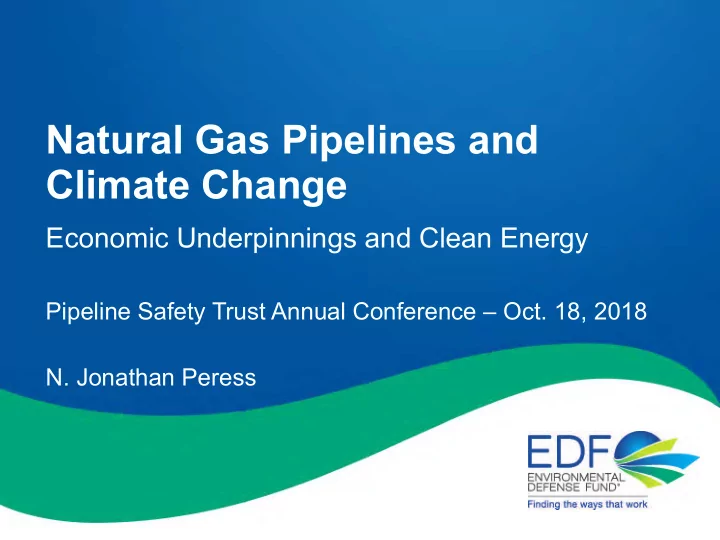

Natural Gas Pipelines and Climate Change Economic Underpinnings and Clean Energy Pipeline Safety Trust Annual Conference – Oct. 18, 2018 N. Jonathan Peress
Topics and Summary • Nat gas pipeline expansion based on rational economic test [FERC] • Diminishing economic rationale for further capacity expansion • Incompatibility between gas transportation market and needs of largest user – power gen • Lower cost clean energy and climate policy create stranded cost risks 2
Unprecedented Buildout in 2017 Additional 30.8 Bcfd of capacity and 2,739 miles of pipeline approved by FERC in 2017. 3
Basis Differentials Largely Eliminated – undercutting justification for capacity expansion 4 Source: FERC 2017 State of Markets; from Platts Daily Price Survey Data
Electric Generation Largest and Growing Gas (and pipeline) User FERC 2017 State of Markets Report 5
Gas / Electric Misalignment – Obscured Pricing Structures Gas pricing – gas price is based on a daily index price, yet the value of gas supply varies by hour. 6
Gas / Electric Misalignment – Market Assumes Steady Takes The vast majority of transactions assume steady flow, but power generators take gas at varying rates over the day. 7
Consequences of Misalignment • Because the gas delivery services needed and used by power plants are not compensated, the market does not efficiently moderate between demand and pipeline supply – In other words, we don’t effectively use the pipeline capacity we have • The lack of transactional mechanisms between pipelines and generators obscures the market investment signal for pipeline capacity – Right sized solutions – Pipeline alternatives 8
Value of Pipeline Capacity is Decreasing in a web-like network with dispersed supply basins But has the ability to offer enhanced delivery services to power generators, which could provide the intraday flexibility to meet the needs of a peakier and more 9 renewable, dynamic electric system. But those services are unpriced.
Clean Energy Solutions Cost Less 10
An optimized clean energy portfolio is more cost-effective and lower in risk than a proposed gas plant. The long term cost of new pipeline capacity increases the clean energy cost advantage. Source: RMI 11
By 2040, clean energy portfolios will cost less to build and operate than an existing (sunk cost) combined cycle power plant. 12
Proposed/Expected Useful Life for Recent Pipeline Capacity 13
On the flip side, legacy operators are acknowledging risk • Sabine Pipe Line LLC, Rate Case, Docket No. RP15-1322, (September 30, 2015): “Alternative energies, such as wind and solar, are likely to offer a viable competitive alternative to natural gas, particularly over a 35-year period.” • Tallgrass Interstate Gas Transmission, LLC, Rate Case, Docket No. RP16-137, (October 30, 2015): “the average PPA price for wind in 2013 and 2014 are below natural gas fuel costs alone.” • Dominion Cove Point LNG, LP, Rate Case, Docket No. RP17-197, (November 23, 2016): “There are many items that contribute to future uncertainty about natural gas demand in the long-run, including the technological development of alternative energies and renewable energies, potential gains in energy efficiency, and laws and policies that support the adoption of these technologies, alternatives, and efficiencies. These changes could reduce the demand for natural gas in the long- run, negatively impacting the demand for all of DCP’s services … .” 15
Climate Consequences of Overbuild • Stranded costs and/or fossil lock in – But only insofar as energy ratepayers bear the costs and risks for infrastructure • Where investors bear risks, they will lose money as clean energy diminishes demand • Market-based infrastructure investment is not adverse and can be beneficial • Thank you for your time. 15
Recommend
More recommend